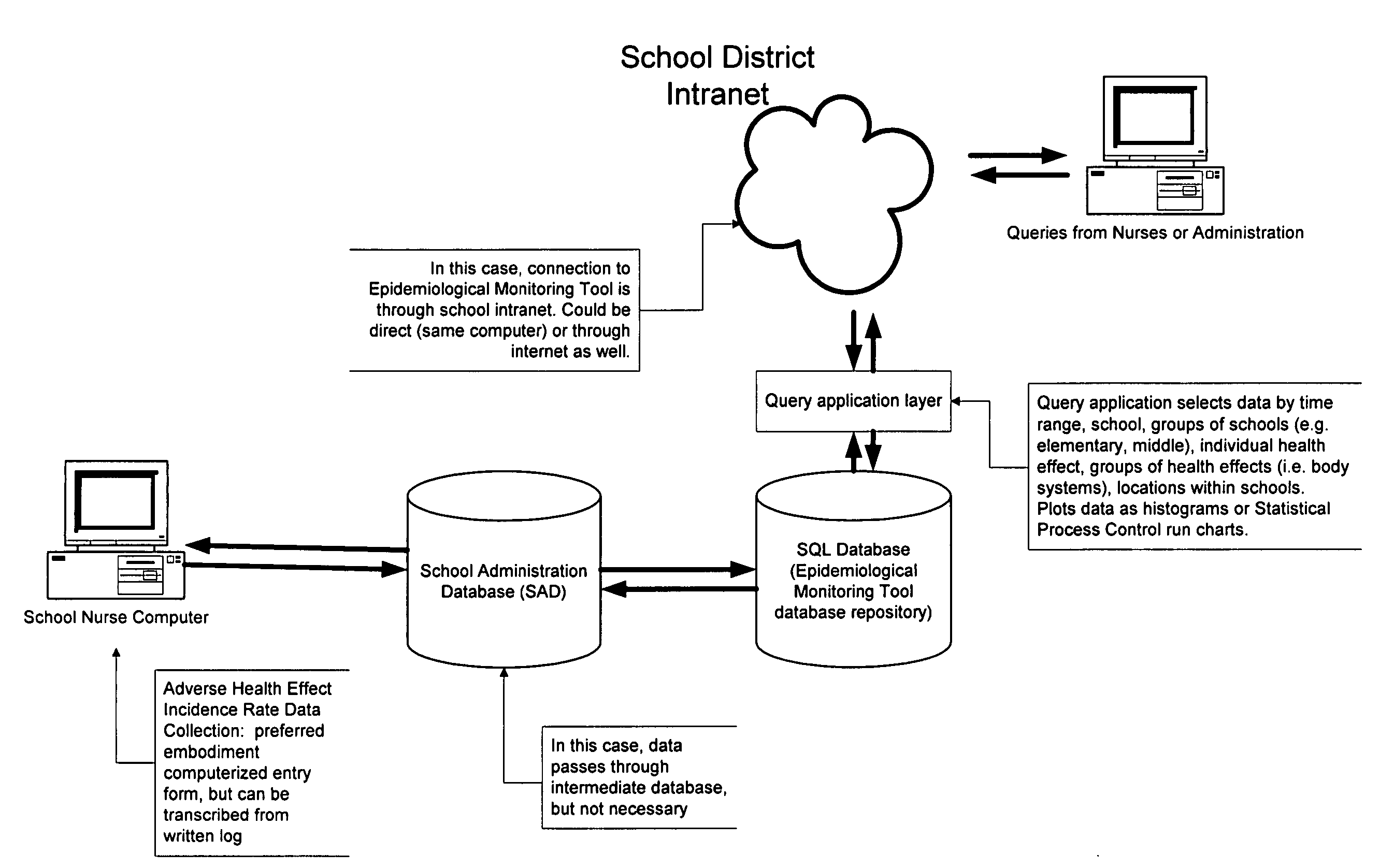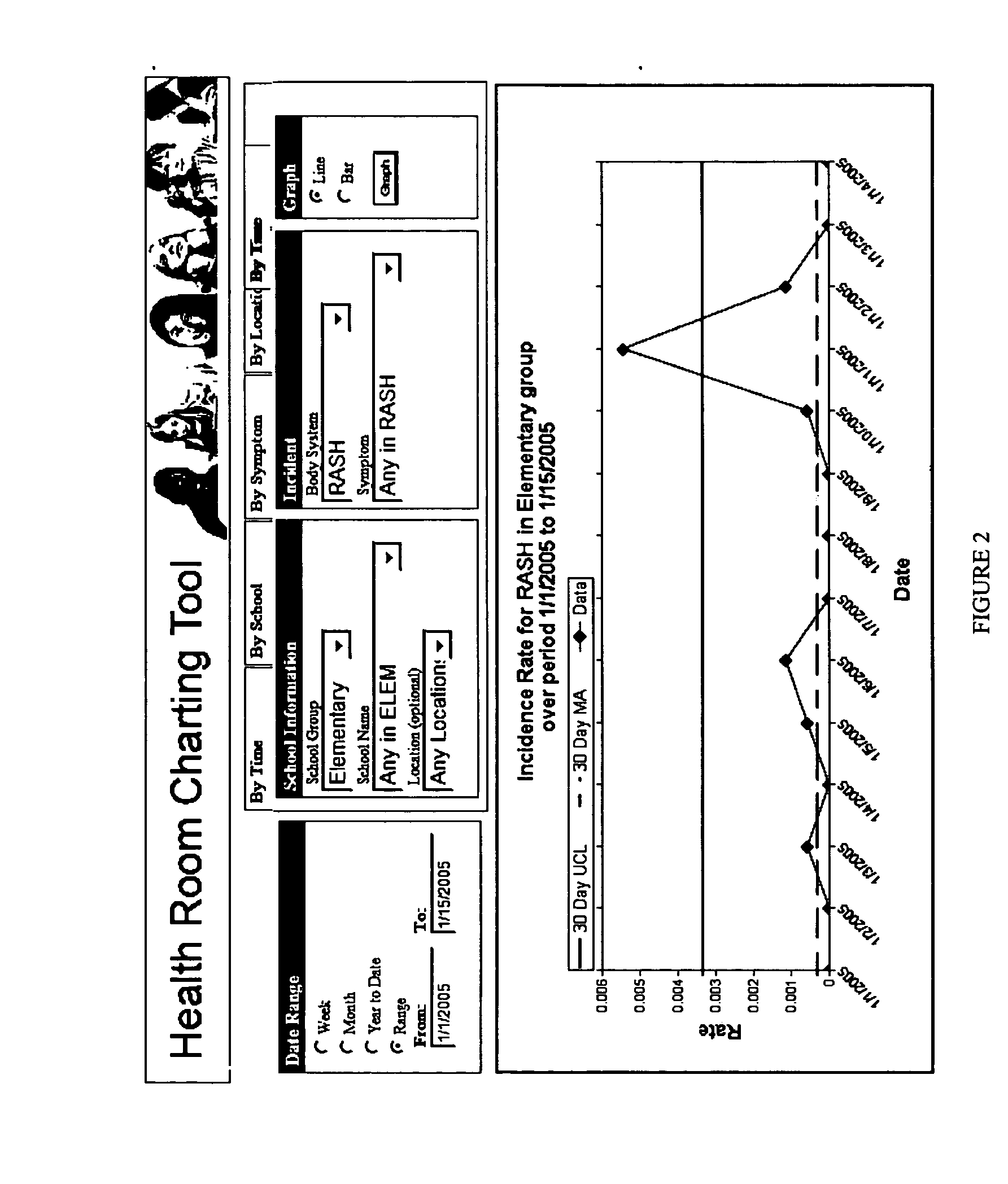System and method for proactive health and environmental management and assessment
a health and environmental management and assessment technology, applied in the field of systems and methods for epidemiological and environmental monitoring and assessment, can solve the problems of difficult monitoring, inherently complex and heterogeneous, and school children, in particular, are more susceptible to experiencing adverse health effects from harmful environmental factors, and achieve the effect of healthy environmen
- Summary
- Abstract
- Description
- Claims
- Application Information
AI Technical Summary
Benefits of technology
Problems solved by technology
Method used
Image
Examples
example i
(The inventive epidemiological and environmental monitoring and assessment system and method was implemented and shown to have substantial utility in a school setting)
[0071] A preferred embodiment is described and understood with reference to FIG. 1.
[0072] A group of schools within a school district meets the criteria of being a population distributed among two or more locations. At each school, students who have adverse health effects (feel ill or are injured) report to a health room staffed by a nurse or health technician. All incidences are recorded on a health log, which provides a continuous source of self-reported data regarding adverse health effects experienced by members of the population. The health log records environmental factor data, minimally including the position of the incident within the location.
[0073] A preferred embodiment was used at a school district comprising three high schools, four middle schools, and eight elementary schools. To implement the exempla...
example ii
(The present invention can be implemented in nursing homes and the like)
[0201] According to additional aspects, in addition to schools, another example meeting the criteria are nursing homes. A group of nursing homes owned, for example, by one corporation, or within a given geographic area, meets the criteria of being a population distributed among two or more locations.
[0202] At each nursing home, medical staff constantly monitor the residents and generate continuous sources of diagnostic data regarding adverse health effects experienced by members of the population.
[0203] The medical records include at a minimum as environmental factor data the nursing home where the resident resides, and preferably additional environmental data.
example iii
(In particular embodiments, additional environmental parameters are monitored to allow for proactive and / or reactive steps)
[0204] According to additional aspects, additional environmental parameters (e.g., airborne carbon dioxide (CO2)) are monitored and correlated with measurements of incidence rates of symptoms of building occupants, especially respiratory and neurological symptoms. A variety of continuous sensors are available to inexpensively and reliably measure CO2 (e.g., sensors based on non-dispersive infrared spectrometry). It is widely recognized that ventilation rates can be inferred from CO2 measurements. Building occupants generate CO2 as a byproduct of respiration, thereby causing indoor carbon dioxide concentrations to exceed outdoor concentrations. The ventilation rate (understood to be the action of supplying outdoor air and removing indoor air from inside a building) can be estimated if the indoor carbon dioxide source strength and the concentrations of CO2 in th...
PUM
 Login to View More
Login to View More Abstract
Description
Claims
Application Information
 Login to View More
Login to View More - R&D
- Intellectual Property
- Life Sciences
- Materials
- Tech Scout
- Unparalleled Data Quality
- Higher Quality Content
- 60% Fewer Hallucinations
Browse by: Latest US Patents, China's latest patents, Technical Efficacy Thesaurus, Application Domain, Technology Topic, Popular Technical Reports.
© 2025 PatSnap. All rights reserved.Legal|Privacy policy|Modern Slavery Act Transparency Statement|Sitemap|About US| Contact US: help@patsnap.com



